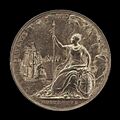Frances Stewart, Duchess of Richmond facts for kids
Quick facts for kids
The Duchess of Richmond and Lennox
|
|
|---|---|

Frances Teresa Stuart by Sir Peter Lely, c. 1662–65.
|
|
| Born |
Frances Teresa Stewart
8 July 1647 |
| Died | 15 October 1702 (aged 55) |
| Other names | La Belle Stuart |
| Occupation | Lady-in-waiting, courtier |
| Known for |
|
| Spouse(s) | |
| Parent(s) | Walter Stewart Sophia Carew |
| Relatives | Sophia Bulkeley (sister) |
Frances Teresa Stewart, Duchess of Richmond and Lennox (born July 8, 1647 – died October 15, 1702) was an important person at the King's court during the time of the English Restoration. She was famous for saying no to King Charles II when he wanted her to be his special friend. Because of her amazing beauty, she was known as La Belle Stuart, which means "The Beautiful Stuart." She also became the model for the famous image of Britannia. She was one of the "Windsor Beauties" painted by the famous artist Sir Peter Lely.
Contents
Her Life Story
Frances was born on July 8, 1647, in Paris, France. Her father was Walter Stewart, a doctor who worked for Queen Henrietta Maria. Her family was distantly related to the royal family. Her mother was Sophia Carew.
In 1663, when Frances was about 16, she was sent to England. She became a maid of honour and later a lady-in-waiting to Catherine of Braganza, who was the new wife of King Charles II.
The famous writer Samuel Pepys wrote in his diary that Frances was the most beautiful person he had ever seen. Many important people wanted to marry her, including the Duke of Buckingham.
A French nobleman named the Count de Gramont once said that it was hard to imagine someone with so much beauty and so little sense. However, letters she wrote to her husband, which are kept in the British Museum, show that she was actually quite sensible and caring.
King Charles II's Interest
While Frances was at court, King Charles II became very interested in her. He fell in love with her. The King wanted her to be his special friend, but Frances always refused.
In March 1667, Frances married Charles Stewart, who was the 3rd Duke of Richmond and 6th Duke of Lennox. He was a distant cousin of King Charles II. They did not have any children.
After her marriage, the now Duchess of Richmond soon returned to court. She stayed there for many years. In 1669, she became sick with smallpox, which changed her appearance. However, she still remained important to the King. King Charles II later sent her husband, the Duke, to Scotland and then to Denmark as an ambassador. The Duke died in Denmark in 1672.
Later Life
In 1688, the Duchess was present at the birth of James Francis Edward Stuart, who was the son of King James II. She was one of the people who signed a special paper confirming the birth.
She also attended the crowning ceremony of Queen Anne in April 1702. Frances died in October 1702, when she was 55 years old. Much of her money and property was used to buy a Scottish estate. This estate was renamed Lennoxlove in her honor.
Britannia's Face
After a war called the Second Anglo-Dutch War, King Charles II had a special medal made to celebrate the peace in 1667. According to Samuel Pepys, Frances's face was used by the artist John Roettiers as the model for the image of Britannia.
Roettiers then used this image for the back of copper coins starting in 1672. This was the first time the image of Britannia had appeared on coins since Roman times. This started a long tradition of Britannia being shown on British coins.
In Books and TV
Frances Teresa Stewart has appeared in many stories:
- Forever Amber by Kathleen Winsor (1944)
- A Health Unto His Majesty by Jean Plaidy (1956)
- The Lady on the Coin by Margaret Campbell Barnes & Hebe Elsna (1963)
- The Sceptre and the Rose by Doris Leslie (1967)
- The Painted Lady by Maeve Haran (2011)
- Girl on the Golden Coin by Marci Jefferson (2014)
- Dark Stars by C.S. Quinn (2016)
- The Great Fire (miniseries) (TV show) where she was played by Antonia Clarke
Images for kids


